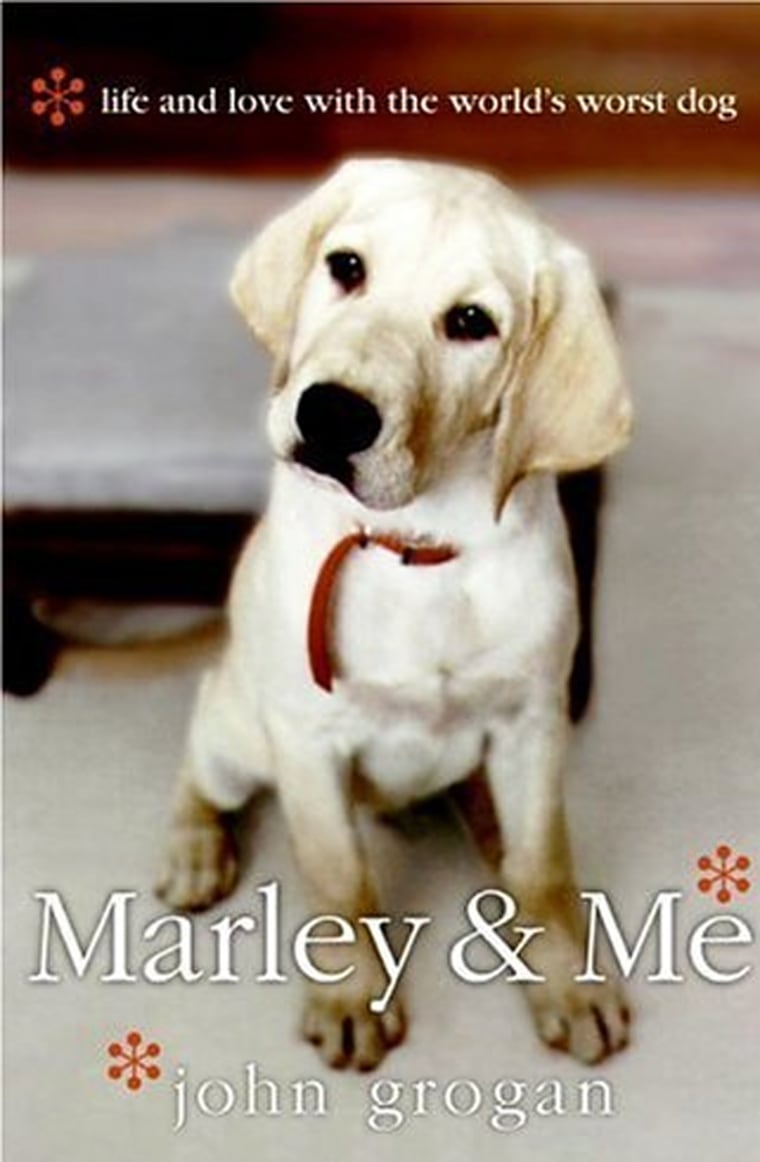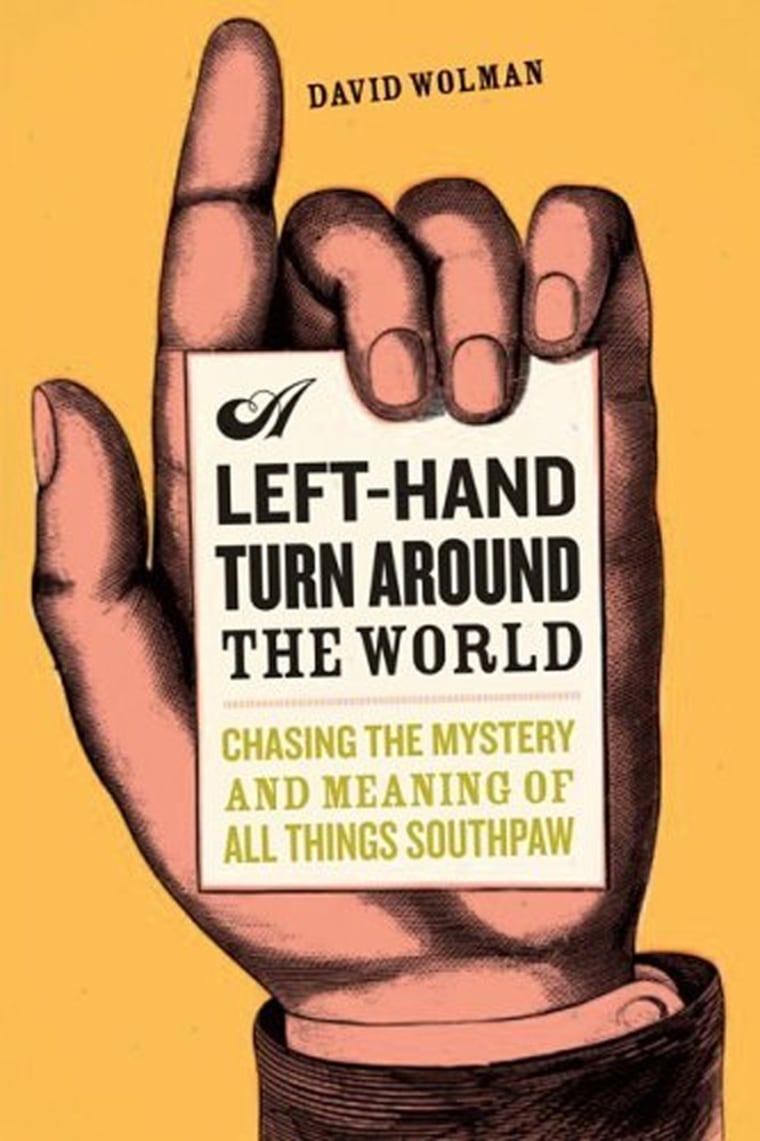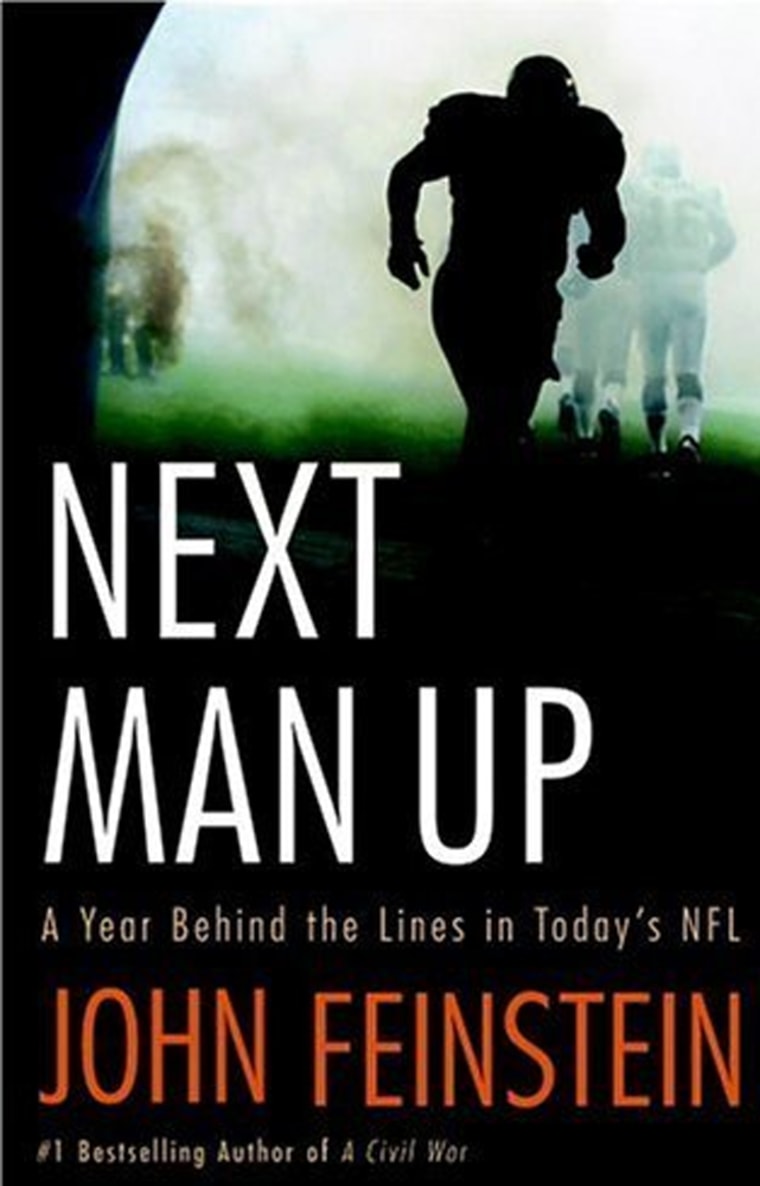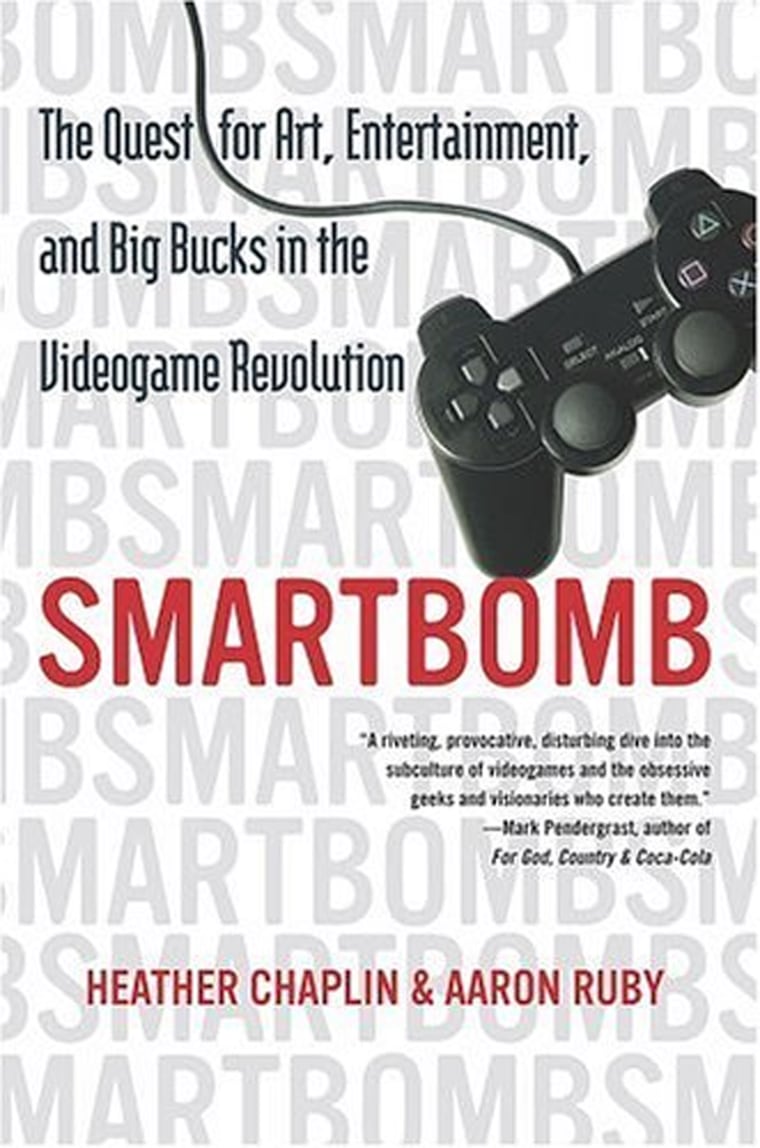At holiday time, nonfiction books often make easier gifts than novels. Not everyone knows which authors gift recipients prefer, but they can generally hone in on a topic that said recipient would enjoy.
Even from our small sampling of new nonfiction, we can spot plenty of good gifts. Dog lovers will laugh and cry over "Marley and Me," one owner's tale of a much-loved and goofy Labrador retriever. Football fans will curl up and read the off-season away with "Next Man Up," which takes readers behind the scenes with the NFL's Baltimore Ravens for one terrible, glorious season. And teachers and students alike, as well as just plain fans of human nature, are likely to enjoy "Teacher Man," in which "Angela's Ashes" author Frank McCourt tells of his 30 years teaching English in New York City schools.
Getting more specific, left-handers should get a kick out of "A Left-Hand Turn Around The World," vintage-clothing fans may appreciate "Alligators, Old Mink, and New Money," and those who can put down their Xbox 360 controllers long enough to rest their thumbs might enjoy "Smartbomb," which takes a look at the video-game industry.
Tales out of schoolIf Frank McCourt could make his poverty-stricken childhood in Limerick hilarious and inspiring, imagine what he does for his 30 years of teaching English in New York City. McCourt's new book, "Teacher Man" (Scribner, $26), is a long-awaited follow-up to "Angela's Ashes" and "Tis," and ye auld man's still got it. On his first two days of teaching, he's dressed down by the principal twice — once for eating a sandwich that a kid tossed in a fight.
McCourt was clearly the kind of teacher kids treasure. He's easy to get off track, always willing to spin yarns of his life in Ireland, and yet there's no question that he loves the kids and lives to teach them. His assignments — write an excuse note from a famous villain, read a recipe aloud and set it to music — have even the most bored kids clamoring to learn. If the book ever drags, it's in its middle section, when McCourt returns to Ireland to pursue a doctorate at Dublin's Trinity College. Away from his students (and his wife, who's a shadowy figure at best in the book), McCourt's vibrant voice drags a bit.
The book sometimes feels structureless, as if the reader is just sitting in a pub with McCourt letting him relate tales of students he's known and classes he's taught. But somehow it works: The tales are fresh and funny, and it would be easy to pull up a stool, quaff a Guinness or two, and let him talk all night. —Gael Fashingbauer Cooper
Gone to the dogsBooks extolling the wonder of pets and children should be approached warily — many run to clichés, and few attack the subject with any new wisdom. John Grogan's "Marley & Me: Life With the World's Worst Dog" (Morrow, $22) would seem ripe for cliche-dom: Marley is a gorgeous, incorrigible Labrador retriever who comes to Grogan and his wife, Jenny, as a puppy and stays with them as they start a family.

Yet the book rises above some others of its topic thanks to Grogan's healthy dose of self-deprecating humor. He knows his dog is a handful, yet can't help smirking as Marley yanks around the snooty dog trainer. He spends days raking through Marley's droppings after the pup eats Jenny's birthday necklace. When Marley gets a role in a movie, Grogan's Hollywood dreams are smashed when the dog eats his leash, slimes costumes, and almost destroys a camera.
This isn't purely a book about a dog, it's more a memoir of the Grogans, with dog worked in throughout. When Jenny miscarries their first child, Marley can't alleviate their sorrow, but he's there when they rise from grief. And as with all pets, there is another loss waiting at the book's end, but as all animal-lovers know, the joys make it all worthwhile. —G.F.C.
‘Horn’ devilishly saxyThe cool, sexy and impressively complex sound of the saxophone can sound so much like a human voice that the instrument bedevils not just listeners, but sax players who obsessively seek a once-in-a-lifetime note they may never recapture again. In Michael Segell’s impressive “The Devil’s Horn: The Story of the Saxophone from Noisy Novelty to King of Cool” (Farrar, Straus and Giroux, $25), the instrument created by crazed genius Adolphe Sax has pushed music and society's boundaries continuously since 1841.
Segell, a journalist and amateur sax player, takes the reader far beyond a history lesson with remarkable interviews about the far-reaching influence of the instrument, from Europe’s military bands to big bands, the Jazz era, rock, R&B, America’s school music programs and the contentious world of classical music. “It cries, it sighs and dreams,” says one early music critic of the sax while another calls its sound an “instinctively animal-like” one that “preys upon the passions and emotions.”
Segell makes the case that the saxophone’s bewitching sound had more than a little to do with society’s changing views on sex in the last century. Just as effective as the meticulously researched musical histories are Segell’s charming interstitial chapters detailing his love affair with the sax and its powerful hold on anyone who dares tame the horn. —Omar L. Gallaga
Left of center
Left-handed people are smarter than righties and more creative; they're more prone to mental illness and clumsiness. We've all heard these stereotypes about "southpaws," but do they have any basis in fact? David Wolman aims to find out in "A Left-Hand Turn Around the World: Chasing the Mystery and Meaning of All Things Southpaw" (Da Capo Press, $24).

Wolman doesn't get many conclusive answers; while lefties differ from "northpaws" in certain aspects of their brain chemistry, many of our cultural assumptions about their relative success in the arts (or refusal to use righty desks) just aren't true. The book delves into every facet of handedness, including its relationship to language, manual dexterity, and sports; lefty graphology; and whether lefties "had a survival advantage" in violent societies.
Wolman's at his accessible and witty best discussing the science of handedness and left-brain vs. right-brain tendencies. Parts of the book, like his visit to a palmistry clinic in Quebec, seem like filler, but the chapter on Japan's national association of left-handed golfers is a nifty slice of anecdotal reporting. "Left-Hand Turn" is an enjoyable look at the social and scientific spectrum of handedness, no matter which hand you use to open jars. —Sarah D. Bunting
First and ten, do it again
One of the wonderful things about journalists is that they can go places and see things others cannot. John Feinstein spent a year following the Baltimore Ravens football team and recorded the results in the engrossing, if a little football-wonky, "Next Man Up: A Year Behind the Lines in Today's NFL" (Little, Brown, $26).

Feinstein obviously likes the Ravens' coaches and players, but presents them fairly neutrally. (The one person he saves his vitriol for is Redskins' owner Daniel Snyder, who comes off as a bit of a buffoon.) Readers don't have to be Ravens' fans to appreciate "Next Man Up," but they had better be football fans. The book doesn't get terribly jargony, but the pages of football strategy will be hard to follow for non-sports buffs — but then, why would they be reading this book? —G.F.C.
Home and Away
When Said Hyder Akbar’s father returned to his native Afghanistan after Sept. 11 as a regional governor, Hyder asked to accompany him, to observe — and possibly to help. “Come Back to Afghanistan: A California Teenager’s Story” (Bloomsbury, $25) is Hyder’s memoir of the three summers he spent with his father in Afghanistan.
It’s a captivating read: well-written, touching and funny by turns, deeply personal and historically relevant. As an Americanized teenager with Afghan roots, Hyder can put both Afghan politics and American coverage of them in perspective. He witnesses significant events (“I feel like I’m living through the Federalist Papers”), but personalizes his story with anecdotes — buying tickets at an airport snack bar, or his American stomach’s reaction to Afghan cuisine. He serves as a translator for a detained prisoner at the American base, but can also crack wise about his beloved uncle Rauf Mama’s glass eye.
Hyder recorded his experiences an audio journal for NPR, and he and his co-author, NPR editor Susan Burton, have put together a deftly written book — but it’s Hyder’s eye for detail that powers it, and when he’s talking about family friends, or interviewing an old man about a notorious massacre, he opens a window into a faraway culture. —Sarah D. Bunting
Clothes off your backFrom time to time, someone writes a book about herself that desperately needed to be written by someone else entirely. Alison Houtte’s “Alligators, Old Mink and New Money: One Woman’s Adventures in Vintage Clothing” (William Morrow; $24) is such a book. Houtte got writing help from her sister Melissa, but her self-congratulatory tone destroys the narrative.
The story of Houtte’s life as a young model in Paris who later opened a vintage clothing store in Brooklyn has interesting moments, particularly surrounding her widely questioned move to Flatbush Avenue. But it eventually becomes embarrassing reading story after story where the ending is always the same: Houtte does something wonderful, perfect, or brilliant. If she goes to a fancy party, someone famous will tell her how amazing she looks. If someone doubts a decision of hers, she will be proved absolutely right.
Unfortunately, while the world of vintage clothing is potentially a lot of fun to explore, the book is dull. Real clotheshorses may enjoy it, but aside from a few anecdotes about people who shop at her store — the ones that are not ultimately stories about how much those people all adore her — Houtte doesn’t make a very appealing narrator for her own story. —Linda Holmes
Dropping a ‘Smartbomb’ If you thought Mario, The Sims, and the demons from “Doom” were colorful characters, you should see the geeks behind their digital code. As portrayed in “Smartbomb: The Quest for Art, Entertainment, and Big Bucks in the Global Videogame Industry” (Algonquin, $25), pioneers of the videogame industry are geniuses, poseurs and hustlers — nerds and outcasts who suddenly find themselves in an exploding industry that outgrosses annual movie ticket sales.

Rather than tackling the entire history of video games, the authors fashion, with impressive access, mini-profiles of some of the most creative minds in gaming, whether they’re launching Microsoft’s Xbox console or helping create the military’s “America’s Army” recruitment game. “Smartbomb” fuses together the heartbreak and growing pains of a fantasyland dealing with the realities of money and power. —Omar L. Gallaga
World of wine, revisitedWine freaks have long been familiar with Ralph Steadman’s previous ode to the vine, “The Grapes of Ralph,” and now the infamously acerbic illustrator of Hunter S. Thompson’s works has compiled a follow-up.
“Untrodden Grapes” (Harcourt, $35) covers similar ground: Steadman explores wine regions from Gascony to South Africa, again turning his pastime into an avocation (funded, in large part, by his label-drawing work for vintners and a British wine merchant) as he extols each locale’s virtues in a mix of Beat prose and his signature style of angular drawings.
His descriptions are even more subjective this time, to the point they occasionally can be disjointed. Some items are lucid and brilliant, like his ode to Alsace, which is as riveting as his section on German wine in the earlier book. Other topics — like his travels through California —are meandering, if poetic. Of dinner with Bonny Doon winemaker Randall Grahm, Steadman mysteriously writes: “He sidesteps and you find yourself playing Ludo with Ho Chi Minh and wine is about revolution and guerrilla warfare in Leeds.”
Of course, the book is intended for casual browsing after one (or many) glasses of wine, so the hippie tone sort of works. Certainly, it’ll resonate among Steadman’s admirable fan base. While not quite as solid an effort as “Grapes of Ralph,” it’s still thoughtfully written and visually dazzling — a wine treatise with almost none of the pretense, and all of the passion. That makes it worth its weight in Sauternes. —Jon Bonné
Gael Fashingbauer Cooper is MSNBC.com's Books Editor. Jon Bonné is MSNBC.com's Lifestyle Editor. Sarah D. Bunting is a writer in Brooklyn. Omar Gallaga is a writer in Austin, Texas. Linda Holmes is a writer in Bloomington, Minn.